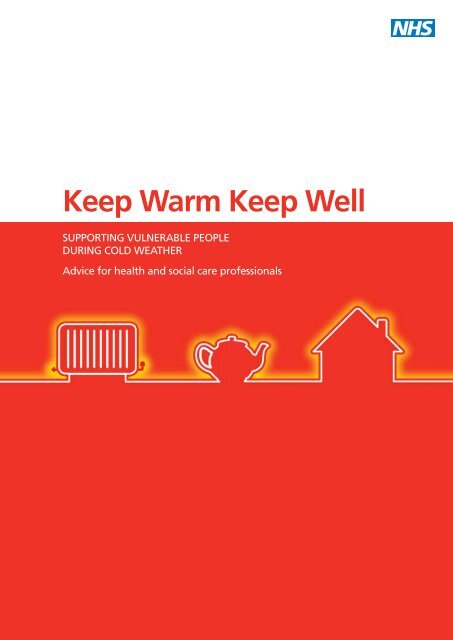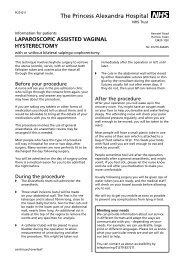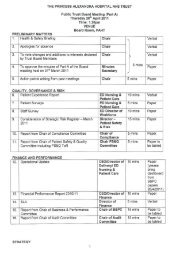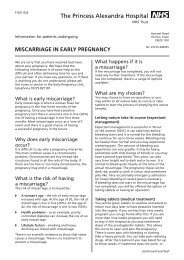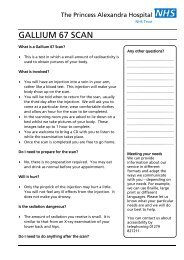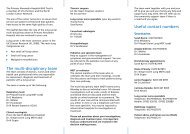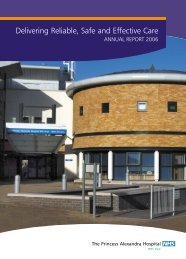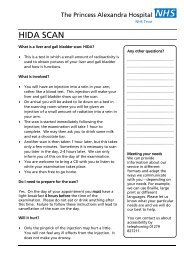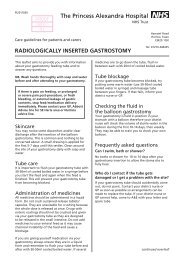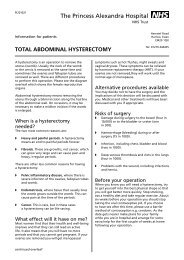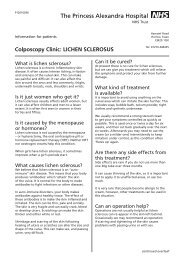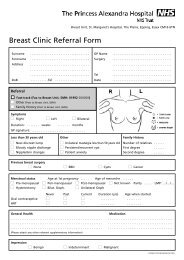Keep Warm Keep Well
Keep Warm Keep Well
Keep Warm Keep Well
Create successful ePaper yourself
Turn your PDF publications into a flip-book with our unique Google optimized e-Paper software.
<strong>Keep</strong> <strong>Warm</strong> <strong>Keep</strong> <strong>Well</strong><br />
SUPPORTING VULNERABLE PEOPLE<br />
DURING COLD WEATHER<br />
Advice for health and social care professionals
<strong>Keep</strong> <strong>Warm</strong> <strong>Keep</strong> <strong>Well</strong><br />
About this leaflet<br />
This leaflet is part of the national <strong>Keep</strong> <strong>Warm</strong> <strong>Keep</strong> <strong>Well</strong><br />
programme – which aims to reduce chronic and acute health<br />
risks associated with cold weather. It contains advice for<br />
people working in primary care or social services, and for<br />
home care providers.<br />
In this leaflet, you will find out about the dangers of cold to vulnerable<br />
people. It will help you plan before and during winter, or for any particularly<br />
cold period.<br />
Contents<br />
Understanding the effects of cold weather . . . . . . . . . . . . . . . . . . . . . .3<br />
Who is at risk?. . . . . . . . . . . . . . . . . . . . . . . . . . . . . . . . . . . . . . . . . . . . . . .3<br />
How do cold temperatures affect health?. . . . . . . . . . . . . . . . . . . . . . . . . . .4<br />
How does living in a cold, damp home affect health? . . . . . . . . . . . . . . . . .5<br />
Taking action to prevent illness and excess deaths. . . . . . . . . . . . . . . . .6<br />
Planning ahead . . . . . . . . . . . . . . . . . . . . . . . . . . . . . . . . . . . . . . . . . . . . . .6<br />
Before a cold snap… . . . . . . . . . . . . . . . . . . . . . . . . . . . . . . . . . . . . . . . . . .7<br />
During a cold snap… . . . . . . . . . . . . . . . . . . . . . . . . . . . . . . . . . . . . . . . . . .8<br />
About hypothermia . . . . . . . . . . . . . . . . . . . . . . . . . . . . . . . . . . . . . . . . .9<br />
Swine Flu . . . . . . . . . . . . . . . . . . . . . . . . . . . . . . . . . . . . . . . . . . . . . . . . .10<br />
Find out more . . . . . . . . . . . . . . . . . . . . . . . . . . . . . . . . . . . . . . . . . . . . .11<br />
2 | SUPPORTING VULNERABLE PEOPLE DURING COLD WEATHER
<strong>Keep</strong> <strong>Warm</strong> <strong>Keep</strong> <strong>Well</strong><br />
Understanding the effects of cold weather<br />
Cold, especially extreme cold, can be dangerous for everyone.<br />
Even in a normal winter, there are tens of thousands of deaths<br />
caused by the cold.<br />
During an average winter, 25,000 people die as a result of cold weather in England<br />
and Wales. If it is a colder winter than normal, there are a further 8,000 deaths per<br />
degree Celsius below the average temperature.<br />
Extremely cold weather can cause mild hypothermia, which increases the risks of<br />
some illnesses – including heart attacks, strokes and respiratory disease – and the<br />
likelihood of falls.<br />
Who is at risk?<br />
Some people are more at risk of becoming ill during cold weather. A number of<br />
factors can determine who is more vulnerable during winter:<br />
• Older age – especially people who are over 75 years old.<br />
• Young age – particularly children with respiratory problems, such as asthma.<br />
• Chronic and severe illness – including heart conditions, respiratory<br />
insufficiency, asthma and COPD (chronic obstructive pulmonary disease).<br />
• Fuel poverty – over 75% of those who cannot afford to adequately heat their<br />
homes are single adult households.<br />
• Inability to adapt behaviour to keep warm – this affects people with<br />
disabilities, babies and the very young.<br />
• Environment and overexposure – such as homelessness, or living in a cold,<br />
damp home with poor or inadequate heating and insulation.<br />
3 | SUPPORTING VULNERABLE PEOPLE DURING COLD WEATHER
<strong>Keep</strong> <strong>Warm</strong> <strong>Keep</strong> <strong>Well</strong><br />
Excess winter mortality by age in England and Wales<br />
35,000<br />
85+ 75–84 65–74 0–64<br />
30,000<br />
Numbers of deaths<br />
25,000<br />
20,000<br />
15,000<br />
10,000<br />
5,000<br />
0<br />
2000–01 2001–02 2002–03 2003–04 2004–05 2005–06 2006–07 2007–08<br />
Year<br />
How do cold temperatures affect health?<br />
A lowering of temperature by 1°C can result in a rise in blood pressure of 1.3 mm Hg.<br />
Higher blood pressure coupled with increased blood viscosity (which is caused by<br />
mild skin surface cooling) increases the risk of strokes and heart attacks.<br />
Cold air also affects the normal protective function of the respiratory tract –<br />
leading to increased broncho-constriction and mucus production, and reduced<br />
mucus clearance.<br />
This table illustrates the effects of living in temperatures below the recommended<br />
16–21°C (or recommended 18°C and over in living areas):<br />
INDOOR TEMPERATURE<br />
EFFECT ON HEALTH<br />
21°C Recommended living room temperature<br />
18°C Minimum temperature with no health risk, though may feel cold<br />
Under 16°C<br />
9–12°C<br />
Resistance to respiratory diseases may be diminished<br />
Increases blood pressure and risk of cardiovascular disease<br />
5°C High risk of hypothermia<br />
4 | SUPPORTING VULNERABLE PEOPLE DURING COLD WEATHER
<strong>Keep</strong> <strong>Warm</strong> <strong>Keep</strong> <strong>Well</strong><br />
How does living in a cold, damp home affect health?<br />
Living in poorly heated or insulated accommodation can worsen underlying health<br />
conditions and affect well-being:<br />
Mild hypothermia<br />
• A study of A&E patients showed greater incidence of hypothermia in those<br />
who were over 65 and living in relatively deprived areas, during periods of cold<br />
weather. Five per cent of these patients showed a core temperature below 35ºC;<br />
34% of this group subsequently died.<br />
Cardiovascular disease<br />
• Around 40% of excess winter deaths are caused by circulatory diseases (there<br />
were approximately 13,000 such deaths in 2005–06).<br />
• The cold increases blood pressure – one study showed that a 1°C lowering of<br />
living room temperature led to a rise in blood pressure of 1.3mm Hg.<br />
• Higher blood pressure increases the risk of heart attacks and strokes.<br />
Respiratory illness<br />
• Respiratory illness causes about a third of excess winter deaths (there were<br />
approximately 10,500 such deaths in 2005–06).<br />
• The cold lowers resistance to respiratory infections: it impairs lung function<br />
and can trigger broncho-constriction in asthma and COPD.<br />
• Dampness increases mould growths, which can cause asthma and respiratory infections.<br />
Falls and injuries<br />
• Symptoms of arthritis become worse in cold or damp homes.<br />
• Strength and dexterity decrease as temperatures drop, increasing the risk of<br />
falls or injuries.<br />
• Living in a cold home increases the risk of falls among the elderly.<br />
Mental and social health<br />
• Damp, cold housing is associated with an increase in mental health problems.<br />
• Some people become socially isolated, as they are reluctant to invite friends over<br />
to a cold home.<br />
• In cold homes where only one room is heated, it is difficult for children to do<br />
homework – affecting educational and long-term work and health opportunities.<br />
Home energy improvements have led to an 80% reduction in time off school due<br />
to sickness for children with asthma or recurrent respiratory infections.<br />
5 | SUPPORTING VULNERABLE PEOPLE DURING COLD WEATHER
<strong>Keep</strong> <strong>Warm</strong> <strong>Keep</strong> <strong>Well</strong><br />
Taking action to prevent illness and excess deaths<br />
Not all countries that have cold winters experience the same<br />
volume of excess deaths. This suggests that we could be doing<br />
more to prevent them.<br />
In a typical winter, temperatures are low enough to affect the health of vulnerable<br />
people living in cold, damp homes. These health risks worsen during a cold snap.<br />
Cold snaps can happen suddenly, and rapid drops in temperature quickly affect<br />
vulnerable people.<br />
Planning ahead<br />
By planning ahead, health and social care providers can offer care and support for<br />
people at risk in the event of a cold snap.<br />
All high-risk individuals who live alone are likely to need daily contact with care<br />
workers, volunteers or informal carers. Older people, especially older women,<br />
people with chronic or serious illness or mobility problems, or those living in<br />
hard-to-heat accommodation, may need extra care and support.<br />
Cold snaps can take place with little warning, with illness and death occurring within<br />
the first couple of days. In fact, it is possible to predict when excess deaths occur<br />
after a cold snap: deaths caused by heart attack happen two days later; deaths<br />
caused by stroke happen five days later; and deaths caused by respiratory disease<br />
happen 12 days later. So it is best to be prepared before cold temperatures are<br />
forecast – ideally by the beginning of November. Use care plans to help you to assess<br />
which individuals are at risk, and identify what extra help they might need.<br />
6 | SUPPORTING VULNERABLE PEOPLE DURING COLD WEATHER
<strong>Keep</strong> <strong>Warm</strong> <strong>Keep</strong> <strong>Well</strong><br />
Before a cold snap…<br />
If you are treating, visiting, supporting or caring for someone in their own home,<br />
take these steps before the weather turns cold. Where possible, involve their family<br />
and any informal carers.<br />
Top tips – heating in the home<br />
Poor heating is a key factor in many excess winter deaths. People living in cold<br />
homes (those in the lowest quarter of indoor temperatures) are at 20% greater risk<br />
of excess winter death than those living in warm homes (those in the top quarter<br />
of indoor temperatures).<br />
• Ask whether the home is properly insulated: lofts should have at least 10 inches<br />
of insulation, and wall cavities should be insulated too. There are grants available<br />
to help make homes more energy efficient – direct them to the <strong>Keep</strong> <strong>Warm</strong> <strong>Keep</strong><br />
<strong>Well</strong> leaflets to find out more (see page 10).<br />
• Make sure the thermostat is set so that the main rooms are at 21°C during the<br />
day and bedrooms are at 18°C at night.<br />
• See whether they have fitted draught-proofing to seal any gaps around windows<br />
and doors.<br />
Top tips – health and benefits<br />
• Check whether the person needs a benefit entitlement check. If they are eligible<br />
for additional benefits and credits, they could see an increase in their annual<br />
income of over £1,400.<br />
• Make sure they have had a seasonal flu jab.<br />
• Advise giving up smoking – this would improve circulation and reduce the<br />
chance of a heart attack.<br />
Top tips – care and support<br />
• Tell the person to contact the primary care team if one of their informal carers<br />
is unavailable.<br />
• Review their care plan to ensure it contains contact details for their GP, other<br />
care workers and informal carers.<br />
• Check that there are adequate arrangements for food shopping so they don’t<br />
have to go out too much in cold weather.<br />
• Monitor the weather by checking local news and forecasts.<br />
7 | SUPPORTING VULNERABLE PEOPLE DURING COLD WEATHER
<strong>Keep</strong> <strong>Warm</strong> <strong>Keep</strong> <strong>Well</strong><br />
During a cold snap…<br />
There are a number of actions that people can take to keep themselves warm<br />
during winter.<br />
Top tips – keeping warm<br />
• Advise them to close curtains and shut doors to keep heat in the rooms used the most.<br />
• Recommend using hot water bottles or electric blankets (but never both<br />
together) if the bedroom is cold at night.<br />
• Encourage them to eat well – food is a vital source of warmth, so they should<br />
eat regular hot meals and drinks throughout the day.<br />
• Encourage them to keep moving if possible – it is good for health and<br />
improves circulation.<br />
Top tips – for health and social care providers<br />
• Stay in regular contact throughout the cold snap.<br />
• Try to arrange for someone to visit at least once a day.<br />
• Give ongoing advice on keeping warm – the <strong>Keep</strong> <strong>Warm</strong> <strong>Keep</strong> <strong>Well</strong> booklets<br />
contain useful tips on heating and preparing for winter, financial support and<br />
staying healthy during winter. See page 10 to find out where to get them from.<br />
8 | SUPPORTING VULNERABLE PEOPLE DURING COLD WEATHER
<strong>Keep</strong> <strong>Warm</strong> <strong>Keep</strong> <strong>Well</strong><br />
About hypothermia<br />
Hypothermia is a condition where the body becomes dangerously cold. It can be<br />
caused by brief exposure to extreme cold or by prolonged exposure to mild cold.<br />
Hypothermia is a serious concern for older people who might be prone to falls or<br />
collapses. If it’s not treated quickly, it can be fatal.<br />
People with chronic or severe illness are likely to be at particular risk of current<br />
illnesses becoming worse from mild hypothermia. People with respiratory disease,<br />
cardiovascular and cerebrovascular conditions, COPD, asthma, severe mental<br />
illness, Parkinson’s disease and difficulties with mobility are all especially susceptible<br />
to the effects of the cold.<br />
Danger signs<br />
If someone has these symptoms, they may be suffering from hypothermia:<br />
• Very cold skin even under clothes, for example, across the stomach or under<br />
the arms.<br />
• Drowsiness and slurred speech.<br />
• Loss of sensation – not being able to tell when it is cold.<br />
Taking action<br />
If you think someone may have hypothermia, take immediate action:<br />
• Dial 999 for an ambulance.<br />
• Try to warm the person gradually by warming the room, wrapping them in a<br />
blanket or duvet, and giving them a warm drink.<br />
• Don’t give them alcohol or try to warm them up quickly.<br />
9 | SUPPORTING VULNERABLE PEOPLE DURING COLD WEATHER
Swine Flu<br />
For up to date information on Swine Flu, please visit<br />
www.dh.gov.uk<br />
10 | SUPPORTING VULNERABLE PEOPLE DURING COLD WEATHER
<strong>Keep</strong> <strong>Warm</strong> <strong>Keep</strong> <strong>Well</strong><br />
Find out more<br />
<strong>Keep</strong> <strong>Warm</strong> <strong>Keep</strong> <strong>Well</strong> booklets<br />
The <strong>Keep</strong> <strong>Warm</strong> <strong>Keep</strong> <strong>Well</strong> booklets contain useful tips on heating and preparing<br />
for winter, financial support and staying healthy during winter.<br />
They are available from GP practices, pharmacies, NHS walk-in centres, hospitals,<br />
care homes, benefit offices and voluntary organisations.<br />
NHS Direct<br />
Visit the NHS Direct website (www.nhsdirect.nhs.uk) for additional advice on<br />
keeping warm in cold conditions<br />
Winter <strong>Warm</strong>th<br />
Further information and a link to the factsheet on Winter <strong>Warm</strong>th is available at<br />
www.dh.gov.uk/en/socialcare/deliveringadultsocialcare/olderpeople/dh_4076849<br />
11 | SUPPORTING VULNERABLE PEOPLE DURING COLD WEATHER
Crown copyright 2009<br />
298486 1p Sep 09<br />
First published September 2008<br />
Updated September 2009<br />
Produced by the Department of Health<br />
This title can also be made available on request<br />
in Braille, in audio, on disk and in large print.<br />
www.dh.gov.uk/publications


